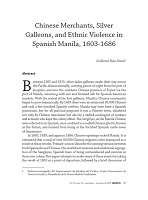Chinese Merchants, Silver Galleons, and Ethnic Violence in Spanish Manila, 1603-1686
DOI:
https://doi.org/10.32870/mycp.v12i36.330Resumen
Between 1565 and 1815, silver-laden galleons made their way across the Pacific almost annually, carrying pieces-of-eight from the port of Acapulco and into the southern Chinese province of Fujian via the port of Manila, returning with raw and finished silk for Spanish American markets. With the arrival of the first galleons, Manila’s Chinese community began to grow dramatically. By 1603 there were an estimated 30,000 Chinese and only a few hundred Spanish settlers. Manila may have been a Spanish possession, but for all practical purposes it was a Chinese town, inhabited not only by Chinese merchants but also by a skilled contingent of workers and artisans who kept the colony afloat. The Sangleyes, as the Manila Chinese were referred to in Spanish, were confined to a walled Chinese ghetto, known as the Parián, and banned from living in the fortified Spanish castle-town of Intramuros. In 1603, 1639, and again in 1686, Chinese uprisings rocked Manila. It is estimated that a total of over 40,000 Chinese migrants were massacred as a result of these revolts. Primary sources describe the existing tension between both Spaniards and Chinese: the exorbitant taxation and residential segregation of the Sangleyes; Spanish fears of being outnumbered and overrun in their own colony. This paper attempts to make sense of these events by taking the revolt of 1603 as a point of departure, followed by a brief discussion of the underlying causes of ethnic violence in Spanish Manila. It then explores the background of Manila’s economic and social structures in order to analyze the Sangley uprisings of the seventeenth century within the context of colonial Manila’s role as the multiracial entrepôt of the trans-Pacific galleon economy. It was in 1603 that the governor of Fujian, under imperial decree, dispatched the assistant magistrate of the port of Haicheng ?? to meet with the chieftain of the so-called Spanish “barbarians” (or xiao xiyang ???). He sailed with a retinue of over a hundred men, and once he met with the governor of Manila, proceeded to inquire about a legendary mountain made of gold allegedly adjacent to Manila Bay, rumors of which had reached as far as the emperor.Descargas
Citas
Amyot, Jacques, The Manila Chinese: familism in the Philippine environment, 2nd ed., Institute of Philippine Culture/Ateneo de Manila University, Quezon City, 1973.
Atwell, William, “International Bullion Flows and the Chinese Economy,” Past and Present, No. 95, 1977, pp. 68-90.
Bjork, Katharine, “The Link That Kept the Philippines Spanish: Mexican Merchant Interests and the Manila trade, 1571-1815,” Journal of World History, Vol. 9, No. 1, 1998, pp. 25-50.
Blussé, Leonard, “Chinese Century: The Eighteenth Century in the China Sea Region,” Archipel, No. 58, 1999, pp. 107-129.

Descargas
Publicado
Cómo citar
Número
Sección
Licencia
Política de acceso abierto
Esta revista proporciona un acceso abierto a su contenido, fiel al principio de que ofrecer al público un acceso libre a las investigaciones ayuda a un mayor intercambio global del conocimiento.
MyCP se publica bajo la licencia de Creative Commons Reconocimiento-No Comercial CC BY-NC
Los contenidos serán publicados en versión PDF y XML.
Los autores(as) que publiquen en México y la Cuenca del Pacífico aceptan las siguientes condiciones:
De acuerdo con la legislación de derechos de autor, México y la Cuenca del Pacífico reconoce y respeta el derecho moral de los autores(as), así como la titularidad del derecho patrimonial, mismo que será cedido a la Universidad de Guadalajara para su difusión en acceso abierto.
México y la Cuenca del Pacífico no realiza cargos a los autores(as) por enviar y procesar artículos para su publicación.
Los autores(as) pueden realizar otros acuerdos contractuales independientes y adicionales para la distribución no exclusiva de la versión del artículo publicado en México y la Cuenca del Pacífico (por ejemplo, incluirlo en un repositorio institucional o darlo a conocer en otros medios en papel o electrónicos) siempre que indique clara y explícitamente que el trabajo se publicó por primera vez en México y la Cuenca del Pacífico.
Una vez que se acepte el artículo para su publicación los autores(as) deben remitir el formato de carta-cesión de derechos de la publicación debidamente requisitado y firmado por los autores(as). Este formato debe ser remitido en archivo PDF paralelamente con la versión final del artículo al correo: mexicoylacuenca@gmail.com.
Los lectores/usuarios de México y la Cuenca del Pacífico pueden acceder directamente al contenido de manera libre y gratuita en todo momento, incluyendo cuando un nuevo número es colocado en la plataforma. Se permite al lector/usuario citar, compartir (electrónicamente y de manera física), imprimir y distribuir el material siempre que se indique de manera clara y explícitamente que el trabajo se publicó por primera vez en México y la Cuenca del Pacífico. Es necesario citar de manera correcta el trabajo y no debe de ser utilizado con fines comerciales.




